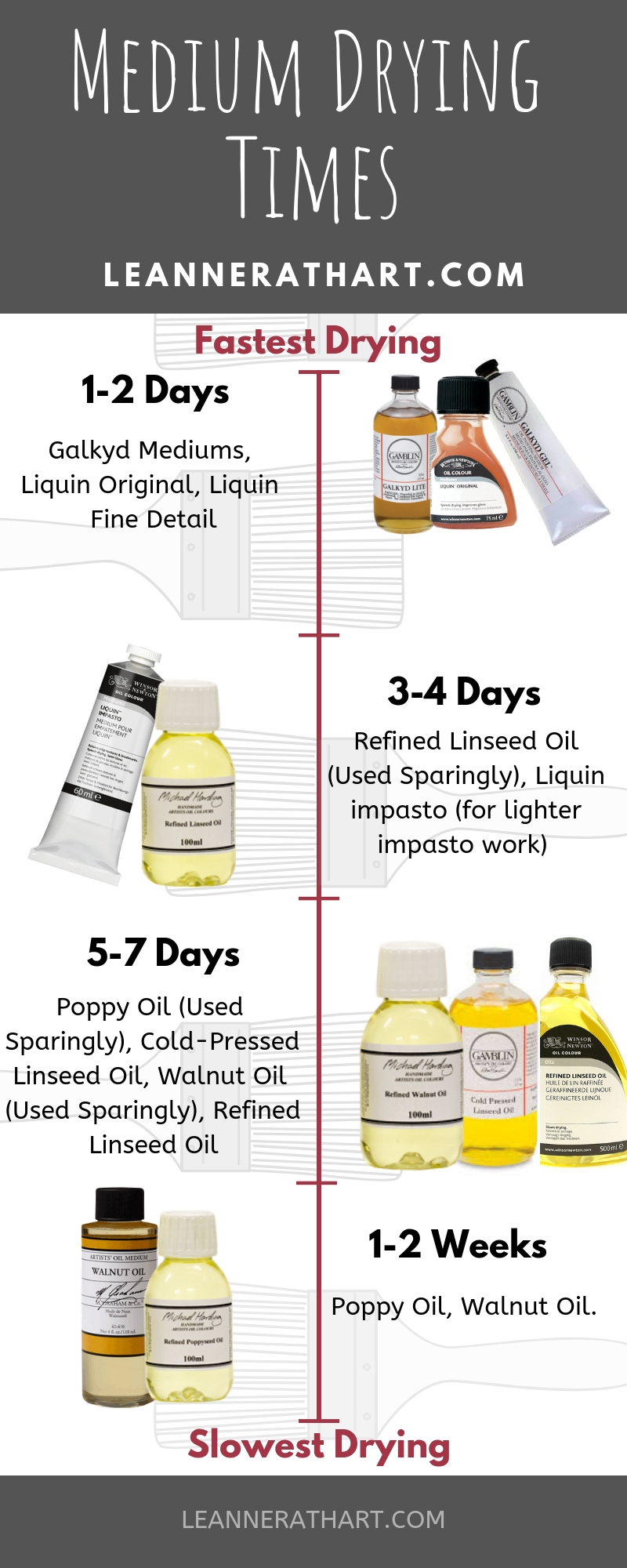Oil painting is an information-heavy enough subject, but trying to learn about all of the different medium types and their usage and drying times can feel hopeless. It's hard to know which ones to try, and how they react with eachother; and worse still, how fast each dries so you can use the fat over lean rule (this means each layer should be slower drying than the last; oil paintings can crack if layers on top dry faster than the layers on the bottom). I've tried each and found my favourites; now's the time for you to, too! Depending on whether you want to paint numerous layers or paint all into one layer, you'll want a faster or slower drying time of your paint, which can be helped using mediums. I've compiled a list of different mediums, and their rough drying times (it can vary slightly depending on humidity and how much of the medium you use) to help you find your way!
Fast Drying Mediums
Personally, I adore fast drying mediums. It allows my process to be quickened, as I'm not waiting for each layer to dry for days on end. For underpaintings, I use Gamblin's Galkyd Gel, with probably about 2 parts gel and 1 part paint to really speed up the drying process and make the paint slightly translucent. This can dry within 8 hours, and be ready for the next layer, which I adore! I wouldn't recommend using so much medium in your paint for further layers, however. Other fast drying mediums include Windsor and Newton's Liquin original/fine detail, and Gamblin's Galkyd Lite, which fasten up the speed of drying the more paint you add, probably about 1-2 days depending. And, of course, painting in much thicker layers will require more drying time, so although Liquin Impasto is a fast drying medium, it'll probably take a few days more than the rest to dry if you're using it for impasto work.
Normal Drying Mediums
If you'll want to work into the painting over a few sessions, you're much better off going for medium drying times; not too fast, and not too slow. With mediums such as refined linseed oil, you can work into the paint for a few days after laying down the initial layer. When using drying oils on their own, be careful not to use too much oil in the paint. For initial oil based layers, I might add about 1 part oil to 4 parts paint, and increase the amount slightly for proceeding layers. Note that while it might only take 3-5 days for refined linseed oil to dry when mixed in these proportions, as you increase the amount it may take longer, so if you're planning on doing a lot of layers, you may want to use a fast drying medium (and remember to use these first; let's not forget the fat over lean rule!). Cold-pressed linseed oil takes a little longer than refined linseed oil to dry, so make sure to note which type you buy!
Slow Drying Mediums
Slow drying mediums are great for if you'll want to work into the paint for a much longer time (say you want to work on a layer for a little each night for a week; this might be the one for you). They're also better used in final layers, or sparingly, as you'll have to be careful to make sure the layers underneath don't dry faster than the topmost layer. Walnut oil and poppy seed oil are slower drying than linseed oil, so they're optimal for final layers or working alla prima over a long period.
It's worth noting that a lot of people add 1 part solvent into 1 part oil when using a drying oil as a medium; this can quicken drying times and make for a nicer textured medium depending on what you're looking for, but it's also fine to use just the oil as a medium (although remember to go incredibly sparingly at the start if you're planning on building up layers). Using the pure oil makes it easier to push paint around on the canvas, and gives a much glossier effect.
I hope this guide will come in useful to you, and if you're new to painting, why not check out my article on oil painting techniques for beginners?
What's your favorite medium? Tell me in the comments below!





